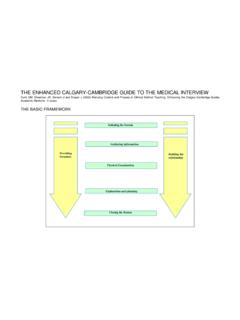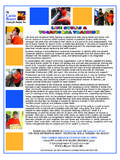Transcription of CALGARY - CAMBRIDGE OBSERVATION GUIDE TO ... - skills …
1 All content is copyright by original owners On any reprints please include references as shown on the last page of the GUIDE CALGARY - CAMBRIDGE GUIDE TO THE MEDICAL INTERVIEW COMMUNICATION PROCESS. INITIATING THE SESSION. Establishing initial rapport 1. Greets patient and obtains patient's name 2. Introduces self, role and nature of interview; obtains consent if necessary 3. Demonstrates respect and interest, attends to patient's physical comfort Identifying the reason(s) for the consultation 4. Identifies the patient's problems or the issues that the patient wishes to address with appropriate opening question ( What problems brought you to the hospital? or What would you like to discuss today?)
2 Or What questions did you hope to get answered today? ). 5. Listens attentively to the patient's opening statement, without interrupting or directing patient's response 6. Confirms list and screens for further problems ( so that's headaches and tiredness; anything else ? ). 7. Negotiates agenda taking both patient's and physician's needs into account GATHERING INFORMATION. Exploration of patient's problems 8. Encourages patient to tell the story of the problem(s) from when first started to the present in own words (clarifying reason for presenting now). 9. Uses open and closed questioning technique, appropriately moving from open to closed 10. Listens attentively, allowing patient to complete statements without interruption and leaving space for patient to think before answering or go on after pausing 11.
3 Facilitates patient's responses verbally and non verbally use of encouragement, silence, repetition, paraphrasing, interpretation 12. Picks up verbal and non verbal cues (body language, speech, facial expression, affect); checks out and acknowledges as appropriate patient's statements that are unclear or need amplification ( Could you explain what you mean by light headed"). 14. Periodically summarises to verify own understanding of what the patient has said; invites patient to correct interpretation or provide further information. 15. Uses concise, easily understood questions and comments, avoids or adequately explains jargon 16. Establishes dates and sequence of events Additional skills for understanding the patient's perspective 17.
4 Actively determines and appropriately explores: patient's ideas ( beliefs re cause). patient's concerns ( worries) regarding each problem patient's expectations ( , goals, what help the patient had expected for each problem). effects: how each problem affects the patient's life 18. Encourages patient to express feelings PROVIDING STRUCTURE. Making organisation overt 19. Summarises at the end of a specific line of inquiry to confirm understanding before moving on to the next section 20. Progresses from one section to another using signposting, transitional statements; includes rationale for next section Attending to flow 21. Structures interview in logical sequence 22.
5 Attends to timing and keeping interview on task BUILDING RELATIONSHIP. Using appropriate non-verbal behaviour 23. Demonstrates appropriate non verbal behaviour eye contact, facial expression posture, position & movement vocal cues rate, volume, tone 24. If reads, writes notes or uses computer, does in a manner that does not interfere with dialogue or rapport 25. Demonstrates appropriate confidence Developing rapport 26. Accepts legitimacy of patient's views and feelings; is not judgmental 27. Uses empathy to communicate understanding and appreciation of the patient's feelings or predicament; overtly acknowledges patient's views and feelings 28. Provides support: expresses concern, understanding, willingness to help.
6 Acknowledges coping efforts and appropriate self care; offers partnership 29. Deals sensitively with embarrassing and disturbing topics and physical pain, including when associated with physical examination Involving the patient 30. Shares thinking with patient to encourage patient's involvement ( What I'm thinking now ). 31. Explains rationale for questions or parts of physical examination that could appear to be non-sequiturs 32. During physical examination, explains process, asks permission EXPLANATION AND PLANNING. Providing the correct amount and type of information 33. Chunks and checks: gives information in manageable chunks, checks for understanding, uses patient's response as a GUIDE to how to proceed 34.
7 Assesses patient's starting point: asks for patient's prior knowledge early on when giving information, discovers extent of patient's wish for information 35. Asks patients what other information would be helpful aetiology, prognosis 36. Gives explanation at appropriate times: avoids giving advice, information or reassurance prematurely Aiding accurate recall and understanding 37. Organises explanation: divides into discrete sections, develops a logical sequence 38. Uses explicit categorisation or signposting ( There are three important things that I would like to discuss. Now, shall we move on to. ). 39. Uses repetition and summarising to reinforce information 40.
8 Uses concise, easily understood language, avoids or explains jargon 41. Uses visual methods of conveying information: diagrams, models, written information and instructions 42. Checks patient's understanding of information given (or plans made): by asking patient to restate in own words; clarifies as necessary Achieving a shared understanding: incorporating the patient's perspective 43. Relates explanations to patient's illness framework: to previously elicited ideas, concerns and expectations 44. Provides opportunities and encourages patient to contribute: to ask questions, seek clarification or express doubts; responds appropriately 45. Picks up verbal and non-verbal cues patient's need to contribute information or ask questions, information overload, distress 46.
9 Elicits patient's beliefs, reactions and feelings re information given, terms used; acknowledges and addresses where necessary Planning: shared decision making 47. Shares own thinking as appropriate: ideas, thought processes, dilemmas 48. Involves patient by making suggestions rather than directives 49. Encourages patient to contribute their thoughts: ideas, suggestions and preferences 50. Negotiates a mutually acceptable plan 51. Offers choices: encourages patient to make choices and decisions to the level that they wish 52. Checks with patient if accepts plans, if concerns have been addressed CLOSING THE SESSION. Forward planning 53. Contracts with patient re next steps for patient and physician 54.
10 Safety nets, explaining possible unexpected outcomes, what to do if plan is not working, when and how to seek help Ensuring appropriate point of closure 55. Summarises session briefly and clarifies plan of care 56. Final check that patient agrees and is comfortable with plan and asks if any corrections, questions or other items to discuss OPTIONS IN EXPLANATION AND PLANNING (includes content). IF discussing investigations and procedures 57. Provides clear information on procedures, eg, what patient might experience, how patient will be informed of results 58. Relates procedures to treatment plan: value, purpose 59. Encourages questions about and discussion of potential anxieties or negative outcomes IF discussing opinion and significance of problem 60.

